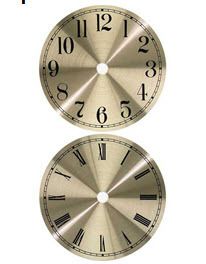
Some clock parts are electronic, suggesting that they utilize 7-segment display screens to build 2 digits for the hour, 2 for the minutes, and in some cases 2 for the secs. Other clock parts are analog, indicating that they include motors, dials, as well as hands from which traditional-looking timepieces are created. We aim to help you decide which way to go.
Digital clock parts tend to be uniform in appearance, the only variety being in terms of style, color, and size. On the other hand, you could spend all day sorting with the wide variety of analog parts.
Diversities abound for the latter, based on a long history of making clocks. Various societies have affected a broad variety of styles in clock dials and hands. Numerals, untethered to the 7-segment pattern, are free to be Arabic, Roman, or symbolic.
One could also argue that the two types differ subtly yet distinctly in terms of exactly what customers get out of a design and also quality viewpoint. People tend to look at an analog clock a lot more favorably, paying equivalent focus on the look and handiwork as they pay to capability. The electronic clock is viewed almost specifically for function.
Now, from the point of view of accuracy, electronic clock motions do a much better task of keeping time. Analog motions use miniature quartz crystals to acquire their timing, and they may drift by as much as 20 seconds a month. Still, this isn’t bad in outright terms.
But the digital parts are just that much more exact. The timing source might not be qualitatively much better compared to a quartz crystal, but electronic neighborhood making use of numerical computer system registers is more accurate than the mechanical technique. At the high end of the digital spectrum are the so-called atomic clocks that make use of radio signals sent by a national standards center in Colorado to synchronize down to the nanosecond.
We are starting to compile a listing of requirements for contrasting analog clock parts with digital. We initially reviewed appearance as well as then accuracy. We now being to special attributes and extensions not only to conventional timekeeping but also beyond it into various other sort of informational screens. Regrettably there is commonly no basis for objective comparison in this department.
Analog and also electronic parts both share simple timekeeping quite adequately. By this we mean revealing minutes and hours in a 12-hour cycle (one of the most usual type of clock). Revealing secs could be left out or consisted of, with the electronic version using 2 more 7-segment displays and the analog version using a second hand (ticking or continuous sweep).
To get 24-hour patterns is not a problem with electronic parts (you merely transform a setting). Yet when utilizing analog parts you have to trade the 12-hour dial with a 24-hour dial. This in turn requires a different clock movement that patterns twice as slowly (the hr hand traversing the circle once a day rather than twice a day).
Likewise, it needs an unique activity, special dial, as well as extra hand to reveal the date in a 31-day calendar month or the day of the week. These are timekeeping extensions you can accomplish with analog parts, and their impact is typically fairly striking. These exact same features are possible to realize digitally (and off-the-shelf clocks often provide them), though it might be difficult for a specific to find the parts to complete it via assembly.
The same discrepancies apply to showing non-temporal information, typically weather-related in some manner. Common examples are temperature level and barometric pressure. A somewhat more exotic example for clocks in coastal areas is the display screen of tide level.
You may discover digital clocks that consist of a thermometer and even a barometer, yet it is unlikely you could track one down that shows the tide. It ares less likely that you would have the ability to put together such a clock yourself from electronic parts.
Nevertheless, the analog globe does provide such parts. Don’t count on finding integrated weather as well as clock movements, but you could get a devoted face, hand, as well as movement for showing temperature, and a different combination of such parts for showing tide. This type of thing affords much chance for creativity.
Alarm clocks are popular, and it should be instead straightforward to develop them from parts. Nonetheless, the alarm system attribute is virtually exclusively component of an off-the-shelf, pre-assembled clock. (You could have far better luck in the digital world compared to in the analog one.).
Chimes are another add-on attribute that is sometimes popular, though less so today than fifty to a hundred years ago. Grandfather and mantle clocks of yore used to play on the hour a tonal pattern, typically the Westminster or Whittington melodies, and follow it with an hour count. Chiming can be attained with analog parts (with several options) but probably not with digital.
Pendulums were a necessary element of mechanical clocks, however nowadays they are used solely for look or uniqueness. They are totally antithetical to electronic clocks, however some analog clock motors supply oscillating nodes to which cosmetic pendulums may be attached.
We wish that these comparisons have been helpful. Clockmakers derive a great deal of pleasure from creating something useful, attractive, and unique. You must now be able to determine whether your clock parts should be electronic or analog.
